Carex filifolia (Thread-leaf Sedge)
| Also known as: | |
|---|---|
| Genus: | Carex |
| Family: | Cyperaceae (Sedge) |
| Life cycle: | perennial |
| Origin: | native |
| Habitat: | sun; dry; plains, gravel prairies, slopes |
| Fruiting season: | May - June |
| Plant height: | 4 to 14 inches |
| Wetland Indicator Status: | none |
| MN county distribution (click map to enlarge): |  |
| National distribution (click map to enlarge): |  |
Pick an image for a larger view. See the glossary for icon descriptions.
Detailed Information
Spikes: 
![[photo of flowering spike]](/udata/r9ndp23q/pd3/carex-filifolia-042016-16-t.jpg) A single spike ½ to about 1 inch long at the tip of the stem; the upper half to 2/3 is staminate (male) and the lower portion pistillate (female) (i.e. androgynous). There is no bract at the base of the spike.
A single spike ½ to about 1 inch long at the tip of the stem; the upper half to 2/3 is staminate (male) and the lower portion pistillate (female) (i.e. androgynous). There is no bract at the base of the spike.
Leaves and stems: 


![[photo of leaves]](/udata/r9ndp23q/pd3/carex-filifolia-042016-19-t.jpg) Leaves are mostly basal, less than 1 mm wide, wiry, the edges rolled up forming a slender tube, up to 10 inches long and about as long as or shorter than flowering stems at maturity. Dried leaves and stems can persist to the next season.
Leaves are mostly basal, less than 1 mm wide, wiry, the edges rolled up forming a slender tube, up to 10 inches long and about as long as or shorter than flowering stems at maturity. Dried leaves and stems can persist to the next season.
![[photo of basal sheaths, broken 1 inch above ground]](/udata/r9ndp23q/pd3/carex-filifolia-042016-21-t.jpg) Bases are wrapped in a brown to reddish-brown sheath that becomes fibrous with age. The old stems eventually break off about an inch above ground, leaving the basal sheath stubble. Stems are slender, 3-sided to round in cross-section and can elongate up to 14 inches at maturity. Not all plants produce flowering stems. Plants form very dense clumps from short rhizomes.
Bases are wrapped in a brown to reddish-brown sheath that becomes fibrous with age. The old stems eventually break off about an inch above ground, leaving the basal sheath stubble. Stems are slender, 3-sided to round in cross-section and can elongate up to 14 inches at maturity. Not all plants produce flowering stems. Plants form very dense clumps from short rhizomes.
Fruit: 
![[photo of mature spike]](/udata/r9ndp23q/grass/carex-filifolia-1-t.jpg) Fruit develops in mid to late spring, the pistillate flowers forming seeds (achenes), each wrapped in a casing (perigynium), subtended by a scale. A spike typically contains 5 to 15 fruits that are appressed to ascending around the stalk.
Fruit develops in mid to late spring, the pistillate flowers forming seeds (achenes), each wrapped in a casing (perigynium), subtended by a scale. A spike typically contains 5 to 15 fruits that are appressed to ascending around the stalk.
![[photo of perigynia, scale and achene]](/udata/r9ndp23q/grass/carex-filifolia-3-t.jpg) Pistillate scales
are 2.9 to 4.5(6.5) mm long, 1.9 to 4 mm wide, broadly oval to urn-shaped with a rounded to blunt tip, sometimes with a minute point at the tip (mucronate), pale red brown to golden with a broad white translucent edging, are about as long as the perigynia and often completely cover it.
Perigynia
are 2.8 to 4.8 mm long, 1.4 to 2 mm wide, brown at maturity, fuzzy hairy at least in the upper half, obscurely veined, generally urn-shaped, the body spherical, tapering towards the base, and an abrupt taper to a short, straight, toothless beak.
Achenes
are 2.2 to 3 mm long, 1.3 to 1.9 mm wide, urn-shaped, 3-sided, and mature to dark brown.
Pistillate scales
are 2.9 to 4.5(6.5) mm long, 1.9 to 4 mm wide, broadly oval to urn-shaped with a rounded to blunt tip, sometimes with a minute point at the tip (mucronate), pale red brown to golden with a broad white translucent edging, are about as long as the perigynia and often completely cover it.
Perigynia
are 2.8 to 4.8 mm long, 1.4 to 2 mm wide, brown at maturity, fuzzy hairy at least in the upper half, obscurely veined, generally urn-shaped, the body spherical, tapering towards the base, and an abrupt taper to a short, straight, toothless beak.
Achenes
are 2.2 to 3 mm long, 1.3 to 1.9 mm wide, urn-shaped, 3-sided, and mature to dark brown.
Notes:
Carex filifolia reaches the eastern edge of its range in Minnesota and is typically found in our western counties in open, silty or gravelly soils. The thread-like leaves (hence the very appropriate common name) can create dense tangles.
Carex is a large genus, with over 600 species in North America and 150+ in Minnesota alone. They are grouped into sections, the species in each group having common traits. Carex filifolia is the lone member of the Filifoliae section in Minnesota; some of its common traits are: clump-forming, basal sheaths brown and fibrous, leaves very slender and thread-like, a single spike with staminate flowers at the tip (androgynous), perigynia hairy on the upper half and nearly round in cross-section, perigynia beaked without 2 teeth at the tip, achenes 3-sided.
Carex filifolia is distinguished from other Minnesota sedges by the combination of: densely clump forming, leaves less than 1 mm wide, a single spike that is androgynous with up to 15 fruits, and hairy perigynia. It may be mistaken for a member of the Acrocystis section, Carex inops in particular, which has broader leaves (up to 4.5 mm), separate staminate and pistillate spikes, and does not form dense clumps.
Native Plant Nurseries, Restoration and Landscaping Services ↓
More photos
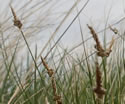 Thread-leaf Sedge plant
Thread-leaf Sedge plant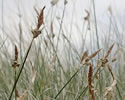 Thread-leaf Sedge plant
Thread-leaf Sedge plant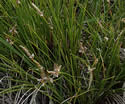 Thread-leaf Sedge plant
Thread-leaf Sedge plant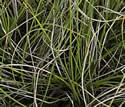 a mat of Thread-leaf Sedge
a mat of Thread-leaf Sedge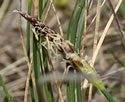 flowering plant
flowering plant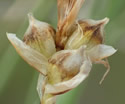 mature spike with only 3 perigynia
mature spike with only 3 perigynia
Photos by K. Chayka taken in the Badlands, South Dakota. Photos courtesy Peter M. Dziuk taken in Pope County and in South Dakota.
Comments
Have you seen this plant in Minnesota, or have any other comments about it?






